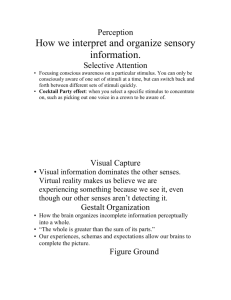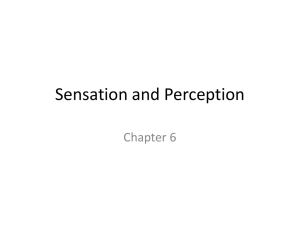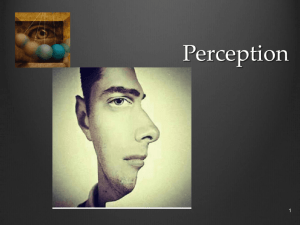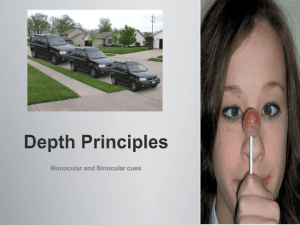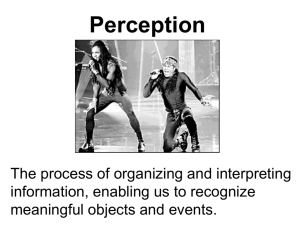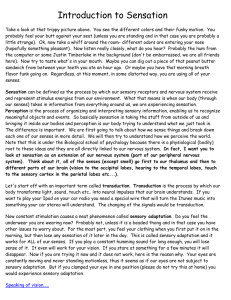Perception
advertisement
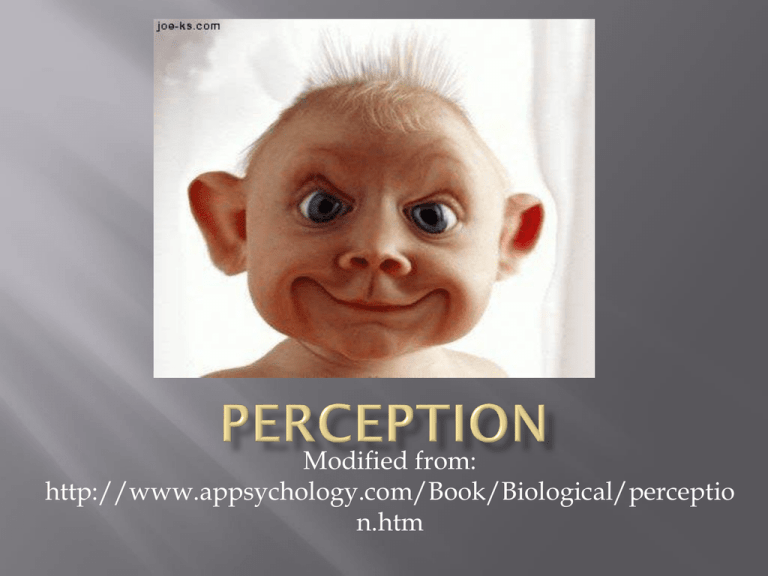
Modified from: http://www.appsychology.com/Book/Biological/perceptio n.htm The way we interpret the information we sense The way we interpret the world in many ways dictates our sense of reality. Even if our senses are keen (like superman on crack), if our perception is skewed we will not understand the information we sense. Thresholds are the idea that our senses have limits. Absolute threshold - the smallest amount you can just sense something (about half of the time.) Example 1: If the guy sitting next to you in class farts, and you take a whiff and smell it, but the next whiff do not smell it, then kind of smell it again- the fart is at your absolute threshold for smell. • Example 2: If you can just barely hear a sound- then it is at your absolute threshold for sound. Difference threshold (or just noticeable difference) the smallest amount of change needed in a stimulus before we notice the change Example: Ok, picture this- you are watching TV (Family Guy or Gilmore Girls- take your pick) and your parents are singing Backstreet Boys in the next room. You grab the controller and raise the volume one bar, but you still can't hear Peter Griffin and his offensive anti-Semitic rhetoric. The change in volume was under your difference threshold (or just notice difference). In fact, you need to raise the volume four bars until you can tell the difference in amplitude. So the difference threshold for your hearing is somewhere between the three and four bars on your TV. There are several theories that psychologists have that show us how we perceive the world. These theories are not in opposition to each other (like McDonalds and Taco Bell- they are more like McDonalds and The Gap- just different). This theory examines how outside influences effect our perception. This theory attempts to predict what we will pay attention to among competing stimuli. For example, they believe that one's absolute threshold depends on your motivation to sense, tiredness, and a whole host of other issues. They question why a new mother will sleep through traffic but awaken upon hearing the smallest whimper from their newborn. • Picture yourself at a noisy party, and someone says your name 10 feet away. You will probably notice that sound above all the others (called the cocktail party effect) because you are motivated to hear your own name. When we perceive the world through top-down processing we are using our experience to fill in the gaps in front of us. Take a look at the following sentence I _ant t_ e_t s_om_ c_tt_n ca_dy. Our schemas often cause us to form a perceptual set (a predisposition to perceive something in a certain way). For example, Beavis and Butthead have a well known perceptual set; sex. Every time someone in their word says the word "tool" or "hard", they see it as sexual. Their schemas for sex are so encompassing that they create this perceptual set so that everything in their lives is seen through the eyes of sexuality. In the 1970's, many parents were concerned aboutbackmasking in music (when you play the music backwards, secret satanic messages are revealed). Now in reality, there is nothing but jumbled noise, but the parents created a perceptual set, expecting to hear devil messages, so what did they hear? What they expected. – http://jeffmilner.com/backmasking/ This type of processing usually occurs when we are unfamiliar with an object. This type of processing is slower, but also prone to less errors than top-down. Instead of using our experience to decipher an object (like in top-down) we use the features of the object itself. We actually examine the object at its basic core structure. Try to picture a five year old who has just learned to read try to decipher I _ant t_ e_t s_om_ c_tt_n ca_dy. They would examine every line and curve because they do not have the experience to do what you or I would do. Psychologist love tackling issues dealing with how we see the world. They examine issues like the figure-ground relationship which deals with how we distinguish what objects in our vision we want to examine (figure) and what parts are just background (ground). In the following pictures what do you see? Which is the background and which is the figure? Gestalt psychologists were a group that explored some of the above issues. In particular they were concerned with how and why we GROUP objects together. They stated that humans can't help but perceive stimuli in groups rather than individual or isolated elements. Gestalt thinkers are obsessed with the notion that we group these objects together in our lives and create groups that are larger than the sum of their parts. If you asked me to sit down and write down all of the feeling that encapsulate the feeling of love I have for my kids, I may spend days writing. But even after I finished the list, it will NOT equal my feelings. My feelings of love (group) are larger than all the individual reasons I have to love. It's kinda cool when you think about it. Proximity: Objects that are close together are more likely to be perceived as belonging in the same group. If you see two people walking down the hallway next to each other, you will probably perceive them as friends. Similarity: Objects that are similar in appearance are more likely to be perceived as belonging to the same group. If there are a small group of Latinos in your class, you may think they all know each other because you view them as similar (you may not be right of course). Continuity: Objects that form a continuous form (such as a trail or geometric figure) are more likely to be perceived as belonging to the same group. Closure: Objects that make up a recognizable image are more likely to be perceived as belonging to the same group even if the image contains gaps that the mind needs to fill in. Just like top-down processing. Remember, our eyes are like mirrors, reflecting information to the back of our retinas. Even though the object we are looking at may change on our retina, we still know the object itself has not changed. That sounds confusing but look at these concepts: Size Constancy: Objects that are closer to us produce bigger images on our retinas. For example, if Mario Lopez was standing 100 feet from you, he would produce a image on your retina. If he dances closer to you, his image on your retina will slowly increase. But you know that Mario (a.k.a. Slater) is not really growing. His size is kept constant in your mind, even though the picture on your retina changes in size. Shape Constancy: Objects viewed from different angles will produce different shapes on our retinas, but we know that the shape of the object remains constant. Take a look at the doors to the right. The one on the left looks like a rectangle, The one in the middle is shaped like a (what do you call it.....) parallelogram? The shape looks different in our retinas, but our mind maintains that the shape of the door remains a rectangle. Brightness Constancy: We perceive objects as being a constant color even as the light reflecting off the object changes. Kermit the frog is green in the daytime. As night comes he will look gray, or even black as the light fades. But we know that his color is always green even though it may not look like so in our retina. The concept of depth is one of the most studied aspects of perception. Imagine what the world would look like if we could not see depth (it would look 2 dimensional). Researcher E.J. Gibson conducted a very famous experiment called the visual cliff experiment to determine when humans are able to see depth. He placed an infant onto one side of a glass topped table that creates the impression of a cliff. Gibson discovered that by the time the baby can crawl, it will not crawl across the glass table, showing us that depth perception does exist at young ages. The general consensus is that babies develop depth perception at around three months of age. The way babies (and adults) understand depth is by using a bunch of tricks that are called monocular and binocular cues. Monocular cues are tricks that we (and artists who draw a lot) use to judge depth perception. What makes them monocular cues is that you need only one eye to use them. So if you lost your eye in a tragic ping pong accident, the following cues would still be at your disposal to see depth. Interposition: So if something is blocking something else, the thing being blocked is farther away- kind of in your face obvious. If Justin Timberlake is standing in front of me and blocking me from looking at Jessica Alba, I am going to assume Justin is closer to me. Texture Gradient: Objects look smoother if they are farther away and rougher if they are closer. To look at Beyonce's face from thirty feet and it will look smooth as pudding. But get right up on her face and you will see crevices, bumps and imperfections all over. Smooth=far away Rough=closer. Relative Size: If we know that two objects are around the same size and one looks a lot bigger in our visual field, you are going to assume it is bigger. The Olsen twins are hanging out at your crib. Ashley looks huge and Mary-Kate looks really small. You are going to assume that Mary-Kate is farther away from you than Ashley or has some type of eating disorderwhich is more likely? Linear perspective: Parallel lines look like the are converging over a distance. Binocular cues are tricks we use to see depth using BOTH your eyes. So if you are missing an eye, these will do you no good. Retinal Disparity: We have two eyes, so the brain gets two images. The more similar the images are between the two eyes, your brain will assume the object is farther away. The more of a difference the images are between the eyes, you brain will assume the object is closer. Convergence: As an object comes closer to us, our eye muscles must strain to stay focused on the object. The brain receives feedback from the muscles controlling eye movements and knows that the more the eye converges, the closer the object must be. It is true that our culture does affect the way we perceive the world. Some cultures, for example, do not use certain monocular cues (like linear perceptive). Take a look at the figure below and quickly me which line is longer. People in western societies tend to perceive the first line as being longer even though they are the same length. If you come from a culture that does not use right angles (non carpentered cultures) you would not be fooled by such an illusion.
